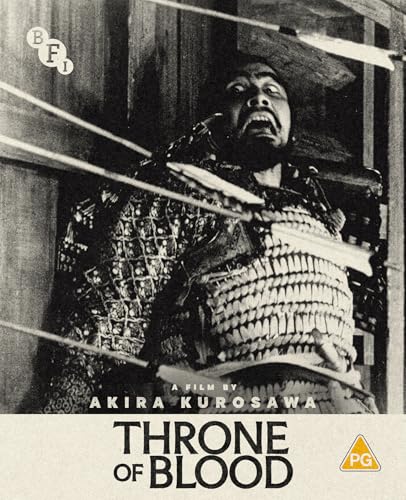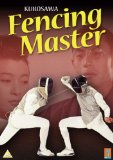![Throne of Blood (4K UHD) [Blu-ray]](/pictures/1167781.jpg) Throne of Blood (4K UHD) | Blu Ray | (19/05/2025)
from £24.25
| Saving you £N/A (N/A%)
| RRP
Throne of Blood (4K UHD) | Blu Ray | (19/05/2025)
from £24.25
| Saving you £N/A (N/A%)
| RRP New 4K restoration of Akira Kurosawa's astonishing film that's considered to be one of the great adaptations of Shakespeare's Macbeth. A truly remarkable film, Throne of Blood manages to combine beauty and terror to produce a mood of truly haunting power. Starring the irrepressible Toshiro Mifune as the doomed warlord Washizu and a wonderfully creepy turn by Isuzu Yamada as the Lady Macbeth-inspired Asaji, the film shows Kurosawa's familiar mastery of atmosphere and action combined with the savagery of war.ExtrasRestored 4K (2160p) UHD Blu-ray presentation in Dolby Vision (HDR10 compatible) Audio commentary by Japanese film expert Michael JeckOther extras tbc
 Throne of Blood (Blu-ray) | Blu Ray | (19/05/2025)
from £16.49
| Saving you £N/A (N/A%)
| RRP
Throne of Blood (Blu-ray) | Blu Ray | (19/05/2025)
from £16.49
| Saving you £N/A (N/A%)
| RRP New restoration of Akira Kurosawa's astonishing film that's considered to be one of the great adaptations of Shakespeare's Macbeth. A truly remarkable film, Throne of Blood manages to combine beauty and terror to produce a mood of truly haunting power. Starring the irrepressible Toshiro Mifune as the doomed warlord Washizu and a wonderfully creepy turn by Isuzu Yamada as the Lady Macbeth-inspired Asaji, the film shows Kurosawa's familiar mastery of atmosphere and action combined with the savagery of war.ExtrasNewly restored in 4K and presented in High DefinitionAudio commentary by Japanese film expert Michael JeckOther extras tbc
![Akira Kurosawa - The Samurai Collection [DVD]](/pictures/1100983.jpg) Akira Kurosawa - The Samurai Collection | DVD | (07/06/2010)
from £35.19
| Saving you £4.80 (13.64%)
| RRP
Akira Kurosawa - The Samurai Collection | DVD | (07/06/2010)
from £35.19
| Saving you £4.80 (13.64%)
| RRP Akira Kurosawa: The Samurai Collection (5 Discs)
![Yojimbo [1961]](/pictures/1004272.jpg) Yojimbo | DVD | (06/11/2000)
from £N/A
| Saving you £N/A (N/A%)
| RRP
Yojimbo | DVD | (06/11/2000)
from £N/A
| Saving you £N/A (N/A%)
| RRP This semi-comic 1961 film by legendary director Akira Kurosawa (Rashomon, Ran) was inspired by the American Western genre. Kurosawa mainstay Toshirô Mifune (Seven Samurai) is cast as a drifting samurai for hire who plays both ends against the middle with two warring factions, surviving on his wits and his ability to outrun his own bad luck. Eventually the samurai seeks to eliminate both sides for his own gain and to define his own sense of honour. Yojimbo is striking for its unorthodox treatment of violence and morality, reserving judgment on the actions of its main character and instead presenting an entertaining tale with humour and much visual excitement. One of the inspirations for the "spaghetti westerns" of director Sergio Leone and later surfacing as a remake as Last Man Standing with Bruce Willis, this film offers insight into a director who influenced American films even as he was influenced by them. --Robert Lane, Amazon.com
![Throne Of Blood [1957]](/pictures/1003692.jpg) Throne Of Blood | DVD | (22/10/2001)
from £12.61
| Saving you £7.38 (58.52%)
| RRP
Throne Of Blood | DVD | (22/10/2001)
from £12.61
| Saving you £7.38 (58.52%)
| RRP A champion of illumination and experimental shading, Kurosawa brings his unerring eye for indelible images to Shakespeare in this 1957 adaptation of Macbeth. By changing the locale from Birnam Wood to 16th-century Japan, Kurosawa makes an oddball argument for the trans-historicity of Shakespeare's narrative; and indeed, stripped to the bare mechanics of the plot, the tale of cut-throat ambition rewarded (and thwarted) feels infinitely adaptable. What's lost in the translation, of course, is the force and beauty of the language--much of the script of Throne of Blood is maddeningly repetitive or superfluous--but striking visual images (including the surreal Cobweb Forest and some extremely artful gore) replace the sublime poetry. Toshiro Mifune is theatrically intense as Washizu, the samurai fated to betray his friend and master in exchange for the prestige of nobility; he portrays the ill-fated warrior with a passion bordering on violence, and a barely concealed conviviality. Somewhat less successful is Isuzu Yamada as Washizu's scheming wife; her poise and creepy impassivity, chilling at first, soon grows tedious. Kurosawa himself is the star of the show, though, and his masterful use of black-and-white contrast--not to mention his steady, dramatic hand with a battle scene--keeps the proceedings thrilling. A must-see for fans of Japanese cinema, as well as all you devotees of samurai weapons and armour. --Miles Bethany
![The Mizoguchi Collection [Blu-ray]](/pictures/1113809.jpg) The Mizoguchi Collection | Blu Ray | (12/03/2012)
from £N/A
| Saving you £N/A (N/A%)
| RRP
The Mizoguchi Collection | Blu Ray | (12/03/2012)
from £N/A
| Saving you £N/A (N/A%)
| RRP Four films from the celebrated Japanese director.Osaka Elegy: (1936) relates the story of a young woman, Ayako Murai (Isuzu Yamada), who engages in a series of affairs to raise money for her family. Initially, she embarks on a relationship with her boss to obtain the money to stop her father going to prison for embezzlement. However, when she begins a second relationship with a work colleague to try and earn money for her brother and boyfriend, Ayako is in danger of going too far and getting herself in trouble.The Story of the Last Chrysanthemum: (1939) follows Kikunsoke Onoue (Shtar Hanayagi), a young actor who is shocked to discover that people have only been patronising him by saying that he is talented. The only person who seems willing to tell him the truth about his acting to his face is Otoku (Kakuko Mori), a servant his family fire and ban him from seeing due to fear of the scandal a relationship between the pair would cause. Kikunsoke and Otoku leave together and Kikunsoke vows to win back his family's affection by becoming a renowned actor. Sisters of the Gion: (1936) focuses on two geisha sisters who have differing attitudes to men. Umekichi (Yko Umemura) believes so strongly in loyalty that she wants to help her lover, Furusawa (Benkei Shiganoya), when he is abandoned by his wife. In contrast, her sister, Omocha (Isuzu Yamada), thinks that the pair should be seeking out wealthy patrons rather than supporting others and attempts to manoeuvre Umekichi away from Furusawa. Utamaro and His Five Women: (1946) offers a semi-autobiographical portrait of the Japanese artist, Kitagawa Utamaro. Utamaro (Minosuke Band), renowned for his portraits of women, finds many of his subjects in Tokyo's brothels. However, will his philandering ways lead him into trouble?
![The Mizoguhi Collection [DVD]](/pictures/1107635.jpg) The Mizoguhi Collection | DVD | (12/03/2012)
from £34.58
| Saving you £-3.33 (N/A%)
| RRP
The Mizoguhi Collection | DVD | (12/03/2012)
from £34.58
| Saving you £-3.33 (N/A%)
| RRP Available on DVD in the UK for the very first time. Titles Comprise: Osaka Elegy: Ayako agrees to enter into an affair with her married boss after he promises to support her and her father. The Story Of The Last Crysanthemum: A young actor is forced to deal with his family after he becomes shunned by them over his new relationship. Sisters Of The Gion: Two giesha sisters disagree over how to deal with the men controlling their lives and livelihoods. Utamaro And His Five Women: A great artist lives to create portraits of beautiful women. A world of passion swirls around him and the women all vie for his attention.
![Criterion Collection: Yojimbo & Sanjuro [Blu-ray] [1962] [US Import]](/pictures/1155173.jpg) Criterion Collection: Yojimbo & Sanjuro | Blu Ray | (23/03/2010)
from £N/A
| Saving you £N/A (N/A%)
| RRP
Criterion Collection: Yojimbo & Sanjuro | Blu Ray | (23/03/2010)
from £N/A
| Saving you £N/A (N/A%)
| RRP ![Criterion Collection: Yojimbo [Blu-ray] [1961] [US Import]](/pictures/1155608.jpg) Criterion Collection: Yojimbo | Blu Ray | (23/03/2010)
from £N/A
| Saving you £N/A (N/A%)
| RRP
Criterion Collection: Yojimbo | Blu Ray | (23/03/2010)
from £N/A
| Saving you £N/A (N/A%)
| RRP ![Classic Kurosawa [1949]](/pictures/1035698.jpg) Classic Kurosawa | DVD | (28/11/2005)
from £N/A
| Saving you £N/A (N/A%)
| RRP
Classic Kurosawa | DVD | (28/11/2005)
from £N/A
| Saving you £N/A (N/A%)
| RRP Throne of Blood (1957): Kurosawa's film career began in 1936 at the Photo Chemical Laboratories in Tokyo. His directorial debut in 1943 Judo Saga bore evidence of his economy of expression and marked his humanist approach. His Rashomon won the top prize at the Venice Film Festival in 1951 and this led to the 'discovery' of his other works and those of his mentors and peers notably Ozu and Mizoguchi. Kurosawa's transposition of Shakespeare's Ma
 The Fencing Master | DVD | (26/01/2009)
from £N/A
| Saving you £N/A (N/A%)
| RRP
The Fencing Master | DVD | (26/01/2009)
from £N/A
| Saving you £N/A (N/A%)
| RRP The Fencing Master (Aka: Tateshi Danpei)

Please wait. Loading...
This site uses cookies.
More details in our privacy policy